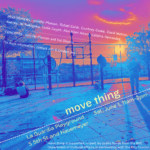We’ve been looking at practitioners of different disciplines to see how they treat time in their work. Choreographer Merce Cunningham used a stopwatch. He expected the dancers to perform each work in a specified duration without any sound cues or other external time-keeping devices. The novelist Jonathan Safran Foer manipulated the speed and direction of time in his story-telling. In Everything is Illuminated, he juxtaposed the forward-moving narrative of small town with the story of a backward-looking, history-seeking protagonist. Both narratives move along until they collide and collapse in one pivotal moment. Historians, according to Michel Foucault in The Archeology of Knowledge, are, in the modern age, interested in disruptions and interruptions in historical narratives, as opposed to their predecessors who posited totalizing theories of linear historical narratives. Former finance consultant Nassim Nicholas Talib, in The Black Swan, shows that history does not happen in the linear narratives which we often study in school. Instead, he says, “history jumps.” The unexpected alters history more than any other event. Thus, it is impossible to predict. John Malkovitch closes The Dancer Upstairs by juxtaposing a young girl’s dance (to Nina Simone’s “Who Knows Where the Time Goes”) with her father’s delayed reflection and rapid facial reaction to a long hardship. Some earth scientists and archeologists speak of eras and eons, time periods delineated by major historical or geological events but also somewhat arbitrarily defined.
These varied practices, theories and understanding of time show that narrative is often our way of framing and thus understanding time periods. Whether it is the sun passing over the sky or the growth of a sunflower, we need a story to help us sense the passing of time and the amount of time passed. Documentation helps us capture and/or tell the story.
If I want to understand a 25-year period of urban growth in New York City as well as the time it takes my lungs to fill and empty with air, perhaps I should document and juxtapose these two stories.
We’re working right now on capturing narratives through images. We’d like to put 2-4 of these narratives together in one flipbook. These flipbooks will be in both video and hard/paper format. The videos are easy to distribute and share with you; the hard copies allow you, the flipper, to determine the speed and direction of the action as you flip through the pages.
We’ll be posting a bunch of photos and links to videos on theremotetheimmediate.wordpress.com. Feel free to comment or offer your own ideas of narratives and juxtapositions.
One large questions looms. How does one capture the experience of movement in images? We’re working on it . . .


Leave a Reply